Fantasy Books
Teaser Tuesdays - The Drowners
 Last night, I dreamt of a windowless room with pale green walls and blank clock faces without numbers. Where time had vanished, and no doors existed.
Last night, I dreamt of a windowless room with pale green walls and blank clock faces without numbers. Where time had vanished, and no doors existed.(First 2 sentences of The Drowners by David A. Anderson)This is an uncorrected ARC, so text and cover might be different on release: March 17, 2025.
---------
Teaser Tuesdays is a weekly bookish meme, previously hosted by MizB of Should Be Reading. Anyone can play along! Just do the following: - Grab your current read - Open to a random page - Share two (2) “teaser” sentences from somewhere on that page BE CAREFUL NOT TO INCLUDE SPOILERS! (make sure that what you share doesn’t give too much away! You don’t want to ruin the book for others!) - Share the title & author, too, so that other TT participants can add the book to their TBR Lists if they like your teasers!
Book review: Death of the Author by Nnedi Okorafor

ABOUT THE AUTHOR: Nnedi Okorafor’s books include Lagoon (a British Science Fiction Association Award finalist for Best Novel), Who Fears Death (a World Fantasy Award winner for Best Novel), Kabu Kabu (a Publisher's Weekly Best Book for Fall 2013), Akata Witch (an Amazon.com Best Book of the Year), Zahrah the Windseeker (winner of the Wole Soyinka Prize for African Literature), and The Shadow Speaker (a CBS Parallax Award winner). Her adult novel The Book of Phoenix (prequel to Who Fears Death) was released in May 2015; the New York Times called it a "triumph". Her novella Binti will be released in late September 2015 and her young adult novel Akata Witch 2: Breaking Kola will be released in 2016.
Nnedi holds a PhD in literature/creative writing and is an associate professor at the University at Buffalo, New York (SUNY). She splits her time between Buffalo and Chicago with her daughter Anyaugo and family. Learn more about Nnedi at Nnedi.com.
Publisher: William Morrow (January 14, 2025) Length: 441 pages
Zelu Onyenezi-Onyedele doesn’t fit in anywhere—not in her high-achieving Nigerian-American family, not in academia, and definitely not in the literary world. She’s broke, disabled, and stuck in the shadow of siblings who actually listened when their parents said “doctor, lawyer, or engineer.” So when she loses her job and another one of her books gets rejected, she does what any loner with nothing left to lose might do: she writes for herself. What comes out is Rusted Robots, a gritty sci-fi epic set in a post-human Nigeria, where robots and AI wage existential war in the ruins of humanity. Against all odds, this weird, raw, wildly creative book becomes a bestseller. Zelu finds fame and money, but she remains an outsider. Death of the Author walks a fine line between literary fiction and Africanfuturism. It’s also a nice example of the book-within-a-book format; we follow the events through Zelu’s life and excerpts from her sci-fi book. I liked how Okorafor shifted between the two genres. And I loved the surprising ending that connected both parts extremely well. But, you know, spoilers. Cultural complexities of Zelu’s Igbo-Yoruba family and the pressures of being a first-generation immigrant influence her story and development. Her relationships—with her family, her work, and herself—are toxic and difficult. Meanwhile, Rusted Robots features solid worldbuilding, even if its chapters sometimes feel too brief. There’s also another layer to the story, the one I rather enjoyed. It contains a sharp commentary on the publishing industry, internet fame, and who gets to tell which stories. While it doesn’t dominate the book, it’s important to the story, especially as Zelu’s rise to fame forces her to confront personal and cultural expectations or social media outrage. Death of the Author is a good story with an excellent ending. It’s not perfect -won’t appeal to everyone—but it’s bold, heartfelt, and entertaining. Bonus points if you’re a fan of robots or literary drama. Audiobook narration: excellent.Book Review: Upon A Starlit Tide by Kell Woods
I received a review copy from the publisher. This does not affect the contents of my review and all opinions are my own.
 Upon A Starlit Tide by Kell Woods
Upon A Starlit Tide by Kell Woods
Mogsy’s Rating: 4 of 5 stars
Genre: Fantasy
Series: Stand Alone
Publisher: Tor (February 18, 2025)
Length: 432 pages
Author Information: Website
I’ve never made secret my feelings for modern fairy tale retellings, which have saturated the fantasy genre in recent years. In fact, I’ve even started DNFing novels that tread this well-worn path—not necessarily because they’re bad, just that I’m not up for the same old same old. But then, every so often, a book will come along that stands out from the crowd by doing something a little different. Kell Woods’ Upon A Starlit Tide is one such novel. Drawing inspiration from multiple fairy tales—a bit of The Little Mermaid here, a bit of Cinderella there, along with a whole smattering of other classics—this history fantasy set in 18th century Brittany blends their many themes together to create something that feels at once nostalgic and entirely on its own.
The story follows Lucinde Leon, affectionately called Luce, the foundling daughter of a successful merchant in the busting and well-fortified seaside town of Saint-Malo. Caught between worlds, Luce chafes at the social expectations imposed upon her and her two sisters. Drawn to the ocean, she dreams instead of a life adventuring on the seas but is prevented from following this path due to her gender and the fact of her misshapen feet. Secretly, she spends much of her time hanging out by the shore where she interacts with the local fishermen, smugglers, and even the occasional water faerie.
One fateful day, however, Luce witnesses a shipwrecked sailor floundering in the ocean and rescues him. The young man turns out to be Morgan de Chatelaine, the charming and handsome son of a powerful shipping family. After locating the de Chatelaine’s doomed ship with her smugger friend Samuel, Luce helps him plunder its valuable cargo of precious sea stones and they discover that poor Morgan was the only survivor of the entire crew. Now awake and recovered from his near drowning, the merchant prince appears to remember that it was Luce who saved his life, and subsequently there is an undeniable spark between them. Meanwhile, despite being adopted, Luce has always been her father’s favorite child and unexpected receives a generous gift from him—a ship to call her own.
Luce’s future now has many possible paths, each shaped by the forces at play around her. But as she navigates the uncertainties of her new circumstances, she must decide where her loyalties lie and what kind of life she wants to build. Her own origins are a mystery that may hold the key to understanding the connection that Saint-Malo has with the fae and offer clues why the world’s supernatural elements seem to be in retreat everywhere.
The storytelling here is multilayered and immersive, painting a richly detailed picture of the world and characters who inhabit it. The addition of the regional mythology results in a distinct flavor for the setting, making this more than just another fairy tale-inspired fantasy. For you see, magic is worked into every thread—all encompassing, but still subtle in some cases. It’s part of their way of life for Luce and those around her, whose livelihoods depend on the sea, a force that can give but also take away. Superstitions are alive and well, especially involving the fae folk and the legends surrounding sea maids and storm stones. This is why it made sense that Upon A Starlit Tide turned out to be a mermaid story, but what surprised me was the inclusion of elements from other well-known fairy tales, completely turning my expectations on their head while keeping me guessing constantly at the direction the plot was going to take.
The set up for all this potential required a lot of description and foundation building, which occasionally slowed the pacing but fortunately the momentum takes off in the second half. While the first half of the book felt like a charming blend of historical realism and fantasy making the world feel both idyllic and enchanting, things take a tense turn as the hidden dangers emerge and secrets begin to unravel. The stakes become far more personal for Luce. Her journey from a restless young woman to someone who has more power than she realizes was satisfying to witness. While there were a few plot developments which I found predicable, there were also some genuinely surprising twists.
Overall, Upon A Starlit Tide is a beautifully written historical fantasy that breathes fresh life into the familiar fairy tell retelling. Although the novel takes its time establishing the world and characters, the payoff was well worth it. Readers who enjoy this subgenre will find much to love about Luce’s journey of self-discovery, adventure, and embracing the magic and mysteries that shape her life.
![]()
![]()
Spotlight on “Goddess Complex” by Sanjena Sathian
Goddess Complex, a biting examination of millennial adulthood, the often fraught conversations around fertility and…
The post Spotlight on “Goddess Complex” by Sanjena Sathian appeared first on LitStack.
What I’ve Been Listening To: February, 2025
 I haven’t shared what I’ve been listening to, since November. How have you lasted this long??? Let’s rectify that right now, shall we?
I haven’t shared what I’ve been listening to, since November. How have you lasted this long??? Let’s rectify that right now, shall we?
ISAAC STEELE & THE FOREVER MAN – Daniel Rigby
This is the first of two originals produced by Audible as The Isaac Steele Chronicles – it’s not a print or digital book turned into an audiobook.
Rigby wrote it, and he narrates as well. He sounds a lot like Cary Elwes, which totally works for me (you want a great audiobook – Elwes’ memoir about the making of The Princess Bride, with several cast members reading their own parts, is superb).
It’s NSFW – I don’t play this one out loud in the office. I’d say ‘raunchy.’ So, take that for what it is.
Steele works for Greatest Britain’s Department of Clarification. He’s basically a police detective for the intergalactic British government. Greatest Britain is about as beloved as Britain was during the Colonial Era. Steele is never the most popular guy in the room. He also drinks, does drugs, has unresolved parental issues, and he’s not exactly a stickler for the rules. A scifi version of the hardboiled private eye trope.
He can be his own worst enemy, but there are plenty of other people, robots, and monsters, willing to make his life worse for him. He has a robotic partner, Timothy, who sulks in his tent like Achilles, after getting benched on the case. Steele is less than gracious in welcoming his new, temporary partner.
This is campy fun, without being silly. I can imagine that there are some seriously devoted fans, on board for more.
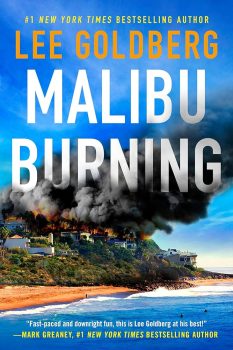 It came out in 2021, and a sequel, Isaac Steele and the Best Idea in the Universe, followed up in 2024. I’m gonna listen to that after I finish this first one.
It came out in 2021, and a sequel, Isaac Steele and the Best Idea in the Universe, followed up in 2024. I’m gonna listen to that after I finish this first one.
Also, I listened to Larry Correia’s three-book Lost Planet Homicide series. I don’t care how you feel about him, or David Eddings, or Josh Whedon (I’m re-watching Firefly right now: man, Fox messed up with that one), or Orson Scott Card, or Neil Gaiman, or whoever. We all make our own decisions on what we watch and read (and what Eddings did hung a bit over my re-read of The Belgariad, which I still love). And the Hugos matter not a whit in my life. If you are bothered I listened to Correia, just move along, or quit reading me, or whatever. Let’s be adults.
Lost Planet Homicide is the title of the first book of the series of the same name. It’s a hardboiled cop (detective) book set in space. It’s definitely tongue-in-cheek, and I get if some people think it’s too over-the-top. But it’s intended to be, and I think it’s more homage than parody.
A colony ship went off course and ended up a thousand light years from Earth. Croatan has five mountain peaks the rise above a fatal cloud of acid that blankets the world. This is not a fun place. Corporations and criminal syndicates call the shots. Murder can be bought off usually. When it can’t, DCI Lutero Cade is called in to…gasp…actually solve the crime! If you think Chandler’s Philip Marlowe and Bay City was cynical, welcome to Five Peaks.
The stakes are epic, and the stories link together, but also stand-alone. Oliver Wyman does hardboiled PI pretty well. Good choice.
I’m a fan of Isaac Asimov’s R. Daneel Olivaw books (I wrote about them here). So, while I don’t do much scifi (which relegates me to the kiddie table at Black Gate gatherings), I don’t mind scifi cop/PI stuff. Both of these were fun listens, with different vibes.
MALIBU BURNING – Lee GoldbergI’m a huge fan of Lee Goldberg’s Monk books. I’ve also listened to all but the most recent Eve Ronin novel, and that is a terrific buddy cop series, set in Hollywood. It occasionally borders on as dark as I get (for a hardboiled fan, I’m a little squeamish), but never goes too far. Can’t wait to get to the most recent one, Dream Town.
Anywhoo, book three of his Sharpe & Walker series is coming in April. Walter Sharpe is an arson investigator, and his new partner is former US marshal Andrew Walker. And this 2023 title about central CA on fire, certainly is timely.
Lee was a terrific screenwriter. Go look up his IMDB page. He and his writing partner William Rabkin penned a couple excellent episodes for A&E’s A Nero Wolfe Mystery. But now Lee is a regular tenant on the NY Times’ best-seller list. He writes fast-paced, absorbing thrillers and crime dramas. I haven’t even managed to get around to his hit series co-written with Janet Evanovich.
I think you could pick any of his series’ (and you can never go wrong with Monk!) and be glad you did. I’m a fan of pulpster Stewart Sterling (real-name, Prentice Winchell). Which includes his Fire Marshal Pedley books (NY Harbor cop Steve Kosko is also fine ‘unconventional’ hardboiled PI). So, a current series, about an arson investigator, written by a top flight novelist, is right up my alley. Definitely recommended.
A POINT OF LAW – John Maddox RobertsBook ten of thirteen in Roberts’ fantastic SPQR series of mysteries set in Ancient Rome. I’ve talked about them here. I absolutely love these stories, and John Lee is the perfect narrator. Click on the link for more info. I have not been disappointed with a single book so far, and I am spacing out the remaining three (Roberts died last year).
He was long working on the next book in the series. I hope they decide to find somebody of quality and have them finish it (Scott Oden?). But I’m really glad I discovered these, late to the party as I was. It sparked an interest in Ancient Rome stuff again. For example, I went and read Michael Kurland’s Roman mysteries short story collection.
ROMAN BLOOD – Steven Saylor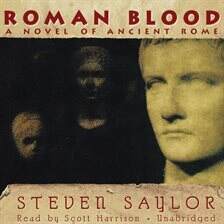 I have written about Saylor’s fictional recounting of the real-life Austin Servant Girl Annihilator. You read that, RIGHT? Saylor is best known for his Roma Sub Rosa mysteries set in…you guessed it, Ancient Rome!
I have written about Saylor’s fictional recounting of the real-life Austin Servant Girl Annihilator. You read that, RIGHT? Saylor is best known for his Roma Sub Rosa mysteries set in…you guessed it, Ancient Rome!
With the Roberts audiobooks fanning the flames; and having read Kurland’s stories: I was ready for more. Saylor was a no brainer.
He has written over a dozen books featuring Gordianus the Finder. Now, he ‘went back’ and wrote a prequel trilogy. I tried to start the first one, The Seven Wonders. Stephen Plunkett was unlistenable. It felt like he was trying to read the entire thing in a monotone. I had to quit.
However, I still wanted to give Saylor a try, so I got the first ‘proper’ Gordianus book, Roman Blood. Scott Harrison was much better as a narrator. I completed it and immediately moved on to Arms of Nemesis.
I like Gordianus. He’s not a public office holder doing official investigations, like Decius Caeceillius Metellus the younger. Gordianus is essentially a private eye. His bartering to get a bigger fee early in book two was amusing. As with most private eyes, he finds himself in peril more than once. And he ruffles important feathers.
I like the authenticity of the Roman world in Saylor’s and Roberts’ books. It really creates a vivid background. And while I love my Hammett and Nebel, the ancient world setting is pretty cool. Roman Blood taker place in 80 AD, in Rome.
I definitely recommend checking out Saylor, and Roberts, if this kind of thing appeals to you.
THE TROJAN WAR: A NEW HISTORY – Barry StraussSo, last week’s post was all about my life-long love of the Trojan War. Which is rooted in the Iliad. I listened to this non-fiction book on the topic, which got me fired up to write last week’s entry. This was a g
I am not really interested in the spate of Trojan War novels (especially the romance ones. Ugh). Though I mentioned last week, being a huge Rex Stout fan, I like The Great Legend. I’ve long intended to read some David Gemmell, and his trilogy of Trojan War novels seems like a no-brainer for that.
But I’m into the original myth, and the study of the war, and the real-life history around it.
Been awhile since I did a non-fiction book. I learned some things. It mixed content from The Iliad, with information related to it. I learned about battering rams (apparently the real ones weren’t like Grond…), sea power, the Greek city-states: just lots of interesting info. And, I always like hearing about Iliad stuff.
This was a good listen, letting me revisit the Trojan War. Sitting and reading this would have been more difficult, for a couple reasons. But the audiobook totally worked.
What I’ve Been Listening To: November, 2024
What I’ve Been Listening To: Sepetember, 2024
What I’ve Been Listening To: August, 2024
What I’ve Been Listening To: July, 2024
What I’ve Been Listening To: September 2022
May I Read You This Book?

Bob Byrne’s ‘A (Black) Gat in the Hand’ made its Black Gate debut in 2018 and has returned every summer since.
His ‘The Public Life of Sherlock Holmes’ column ran every Monday morning at Black Gate from March, 2014 through March, 2017. And he irregularly posts on Rex Stout’s gargantuan detective in ‘Nero Wolfe’s Brownstone.’ He is a member of the Praed Street Irregulars, founded www.SolarPons.com (the only website dedicated to the ‘Sherlock Holmes of Praed Street’).
He organized Black Gate’s award-nominated ‘Discovering Robert E. Howard’ series, as well as the award-winning ‘Hither Came Conan’ series. Which is now part of THE Definitive guide to Conan. He also organized 2023’s ‘Talking Tolkien.’
He has contributed stories to The MX Book of New Sherlock Holmes Stories — Parts III, IV, V, VI, XXI, and XXXIII.
He has written introductions for Steeger Books, and appeared in several magazines, including Black Mask, Sherlock Holmes Mystery Magazine, The Strand Magazine, and Sherlock Magazine.
Review: Tideborn by Eliza Chan
 Buy Tideborn
OFFICIAL AUTHOR BIO: Eliza Chan is a Scottish–born Chinese–diaspora author who “writes about East Asian mythology, British folklore and reclaiming the dragon lady, but preferably all three at once”. Eliza’s work has been published in The Dark, Podcastle, Fantasy Magazine and The Best of British Fantasy, and her non-fiction has appeared on Tor.com. She lives in the north of England with her partner and young child.
Buy Tideborn
OFFICIAL AUTHOR BIO: Eliza Chan is a Scottish–born Chinese–diaspora author who “writes about East Asian mythology, British folklore and reclaiming the dragon lady, but preferably all three at once”. Eliza’s work has been published in The Dark, Podcastle, Fantasy Magazine and The Best of British Fantasy, and her non-fiction has appeared on Tor.com. She lives in the north of England with her partner and young child.FORMAT/INFO: Tideborn will publish on March 25th, 2024 from Orbit Books. It is 384 pages long and will be published in hardcover, ebook, and audiobook formats
OVERVIEW/ANALYSIS: A selfless act may have saved the citizens of Tiankawi, but the city is not out of danger yet. A deadly force is heading towards the city, and this time, it may be unstoppable. Nami the water dragon must lead an expedition out into the open ocean in an attempt to stop the disaster before it's too late. But dangers lurk within the city as well. Tensions between fathomfolk and humans are even worse than before. If Mira the half-siren doesn't find a way to unite the people, the city may tear itself apart from within before any outside force can destroy it.
Tideborn is a bit of a muddled mess as it tries to make sense of a city crippled by prejudice as an impending disaster approaches. Smartly, the magic that saved the city from destruction at the end of Fathomfolk did not also magically solve racism overnight; if anything it made it worse, causing even more fracturing in a populace grappling with dramatic change. But now nearly all of the protagonists' victories are tied to solving racism in some way, and they have to do it in the space of one book.
The author has mixed success in portraying effective resolution of these tensions. Ironically, Nami the water dragon's storyline, which I was less interested in overall, has perhaps the most realistic storyline. She is sent on a mission on a boat with roughly a dozen other people, both human and fathomfolk. Within this microcosm is a range of prejudices and acceptance; in order to achieve her mission, Nami has to find a way to get her crew to set aside their fears and prejudices about each other, while also dealing with her own insecurities. It's not an easy task, but winning the hearts and minds of a handful of people is much easier than that of a whole city.
The rest of the characters are left to deal with the political turmoil in Tiankawi, and this happens less effectively. On the one hand, this makes sense. You can't make the population of an entire city set aside their individual fears and hatreds with the snap of your fingers. But that also means that it's hard to get a satisfying sense of victory. Mira and her allies can triumph over some figureheads, but they really haven't solved the root of the problem by the end of the story. It leads to a somewhat messy finale as none of these internal problems are really resolved, even if the biggest threat was eliminated.
The lack of a cohesive end goal is, at the end of the day, what causes this story to feel a bit scattered. Nami has a clear goal in her mission, but Mira's is a bit more nebulous. She is basically simply trying to hold the city together long enough for either Nami to succeed or for the city to be destroyed. The result is Mira is dealing with several different forces trying to undercut both her and any attempts at peace, leaving her fighting enemies off on all sides. Cordelia the sea-witch, on the other hand, has an even less clear goal, turning her aims this way and that in pursuit of her personal whims.
(And yes, Nami's toxic boyfriend is still around, and yes, you will still want to drop kick him into the sun.)
CONCLUSION: It's hard to sum up my final thoughts on Tideborn. On the one hand, I really appreciate the themes the author is grappling with. But because these themes don't have an easy answer, there's no clear resolution at the end of the day. Yes, some villains are thwarted, but as the story shows, that doesn't dissolve the beliefs of their followers. While I do enjoy the world the author created and the characters that inhabit it, the city at the heart of Tideborn is perhaps too realistically riddled with prejudice for the duology to have a satisfying resolution.
Alternate Londons, the Future of Lotteries, and Colony Ships: January-February Print Magazines
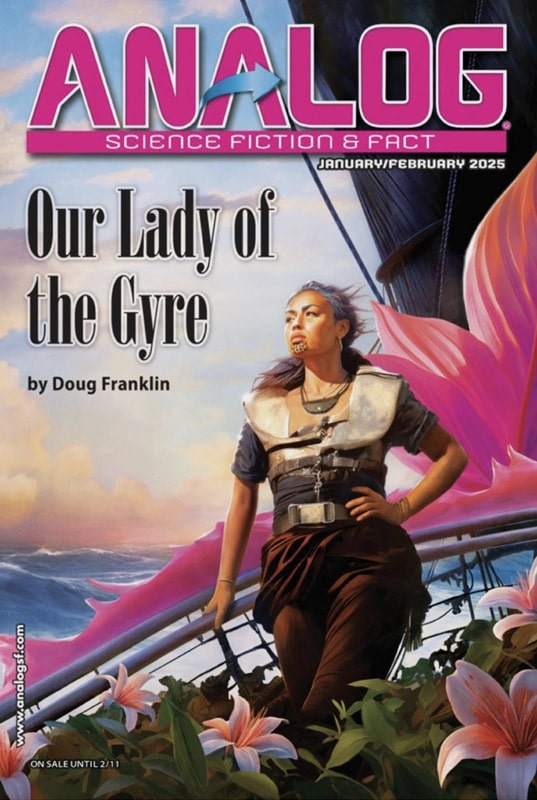
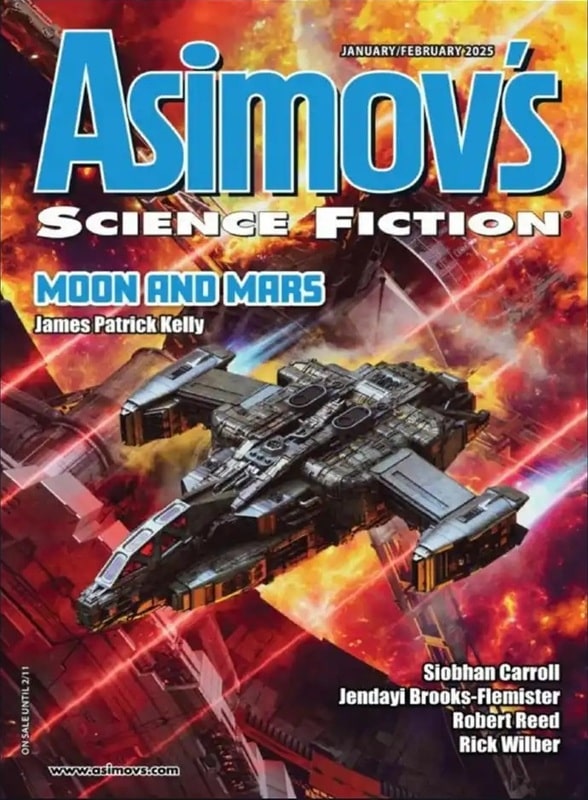
January-February 2025 issues of Analog Science Fiction & Fact and Asimov’s Science
Fiction. Cover art by Tomislav Tikulin (for “Our Lady of the Gyre”) and Shutterstock
Still no sign of the next issue of The Magazine of Fantasy & Science Fiction, which is disheartening. That leaves us with only two issues published last year (Winter 2024 and Summer 2024), and no hint when the next one might arrive. I’m hearing rumors that the magazine has been sold, but I’ve been unable to confirm that, so for now it’s just gossip.
But we’ve got issues of Asimov’s Science Fiction and Analog Science Fiction & Fact in hand, and they’re just as enticing as usual, with contributions from John Shirley, Sean McMullen, Mark W. Teidemann, Steve Rasnic Tem, Paul Di Filippo, Sakinah Hofler, James Van Pelt, James Patrick Kelly, Siobhan Carroll, Robert Reed, Faith Merino, Matthew Kressel, Rick Wilber, Jane Yolen, Kendall Evans, and many more.
The issues contain a new Great Ship tale by Robert Reed, a new Unsettled Worlds story by Siobhan Carroll (which Sam Tomaino calls a “suspenseful, exciting tale”), a new novelette “Rejuve Blues” from John Shirley (which Victoria Silverwolf labels “a suspenseful crime story and psychological study”), and the last installment in James Patrick Kelly’s trio of stories about Marishka Volochkova, “Moon and Mars,” which Sam proclaims is “probably another Nebula nominee.”
Victoria Silverwolf at Tangent Online enjoyed in the latest Analog.
“Our Lady of the Gyre” by Doug Franklin mostly takes place aboard a sea vessel that fights excess carbon dioxide in the atmosphere via bioengineered diatoms. The protagonist, who communicates with an artificial intelligence orbiting the Earth, takes two young people on his ship and faces a dangerous storm… a very dense work of fiction that requires careful reading. At first, it is difficult to tell what’s happening or what this future world is like, but patient readers will be rewarded with a vivid and imaginative tale with appealing characters.
The novelette “Rejuve Blues” by John Shirley features an elderly couple who win a lottery that offers them the chance to be young again. The man runs into trouble with criminals, while the woman, thinking he has left her, returns to her former activity as a fighter against the Taliban. The author creates a complex and convincing future that is neither utopian nor dystopian… a suspenseful crime story and psychological study.
The main character in “Go Your Own Way” by Chris Barnham accidentally discovers a way to travel into alternate versions of London, some very similar to the familiar one and others wildly different. He falls in love in one of these parallel worlds, but the arrival of an alternate version of himself causes complications. The plot is that of the eternal triangle, in which two of the people involved are the same person. (One might call it an isosceles triangle.) The various parallel Londons are described only briefly, and are far more interesting than the love story…
In the novelette “Prince of Spirals” by Sean McMullen, conspirators kidnap a forensic anthropologist and force him to study samples from the skeletons of two bodies thought to be the so-called Princes in the Tower, heirs to King Edward IV of England… The motive is to determine if either Prince survived to have descendants, giving members of the conspiracy a claim to the throne… This is a suspenseful crime story, with intriguing speculative technology and an interesting look at the techniques used by forensic anthropologists.
At first, “Quest of the Sette Comuni” by Paul Di Filippo seems like pure fantasy, as a female satyr and a golem set out to rescue a princess from a wizard, in order to free their master from his imprisonment by a sea-dwelling queen. It soon becomes clear that the golem is actually a machine and the other characters are the result of advanced biotechnology. The setting is richly imagined, from an underwater Venice inhabited by amphibious humans to an antagonist who has made himself resemble the Jabberwock from Lewis Carroll’s famous nonsense poem. Although not a comedy, the story has sufficient amount of subtle wit to draw the reader into its colorful world.
The magazine concludes with the novella “Apartment Wars” by Vera Brook. The setting is Poland in 1979. The widow of a scientist faces the possibility that she will be forced out of her relatively large apartment by the government because she lives alone. She expects her daughter and son-in-law to arrive soon as permanent guests, justifying her need for the place, but time is running out. Meanwhile, the abusive boyfriend of a neighbor threatens to expose her situation to the authorities… The situation takes a dramatic turn when the widow discovers an extraordinary device built by her husband.
Read Victoria’s complete review here.
The new Asimov’s is thoughtfully reviewed by Mina at Tangent Online. Here’s a sample.
“In the Splinterlands the Crows Fly Blind” by Siobhan Carroll takes patience to read. The world building is complex and initially confusing. The protagonist, Charlie, sets off to find his missing brother, Gabe, as well as Gabe’s girlfriend. There are some groovy invented words like Universe-shard, atmotech, Crowmind, Crowdogs and Vestigium — along with words from what seems to be a Cree dialect — they do eventually all make sense. Charlie finds himself a hero as he saves his fragment of world from destruction by the carelessness of “some rich guy stepping on butterflies.” Worth persisting.
“Five Hundred KPH Toward Heaven” by Matthew Kressel is set just after the heyday of lifts into space, reminiscent of train travel. They are being replaced by much faster, cheaper ships. In a final ascent party, Terese reminisces with other lift pilots and ponders on what is being lost — a sense of wonder and a sense of connection — “sometimes there’s benefits to going slow.”
“Shadow of Shadows” by Frank Ward is a pleasure to read because, once you reach the end, the title hits you with its full poignancy. This reader appreciates when an author does this so well. A washed-up research physicist stands at the threshold of finally finding proof for his theory of a “Many Worlds Interpretation.” The proof of alternate universes is, however, not without pain. A tale that explores not just quantum theory but also its emotional repercussions. I would read this twice.
The tension build-up in “What the Frog’s Eye Tells the Frog’s Brain” by Beston Barnett is incredible. One can only say: bravo! In this story, a desperate scientist, being interrogated and tortured by an AI courageously sets out to trick it into shutting down. The references to Linux, Hexspeak and ASCII are very satisfying for this linguist, for AI does indeed have its own language.
“My Biggest Fan” by Faith Merino is a creepy and ultimately sad tale. The narrator grows up seeing the same woman and hearing the same tune at regular intervals; but she is always a different age. She leaves him notes signed “your biggest fan.” When he finally understands why their trajectories keep overlapping, it’s tool late: they have become each other’s hell, as Sartre would say. Quantum particles meet stalker meet Greek tragedy.
In “Moon and Mars” by James Patrick Kelly, Moon-settler Mariska is part of the crew on the Natividad, a colonists’ ship she has joined to be with her Martian boyfriend, Elan. It soon becomes apparent that those with vested interests in the anti-matter that will power the ship through a wormhole to the Destination planet on the other side are trying to stop the mission. Mariska, her mother and Elan are all part of a group determined to take off early before the mission can be stopped. The race against time is gripping…. A great read.
Read Mina’s full review here.
Here’s all the details on the latest SF print mags.
[Click the images for bigger versions.]
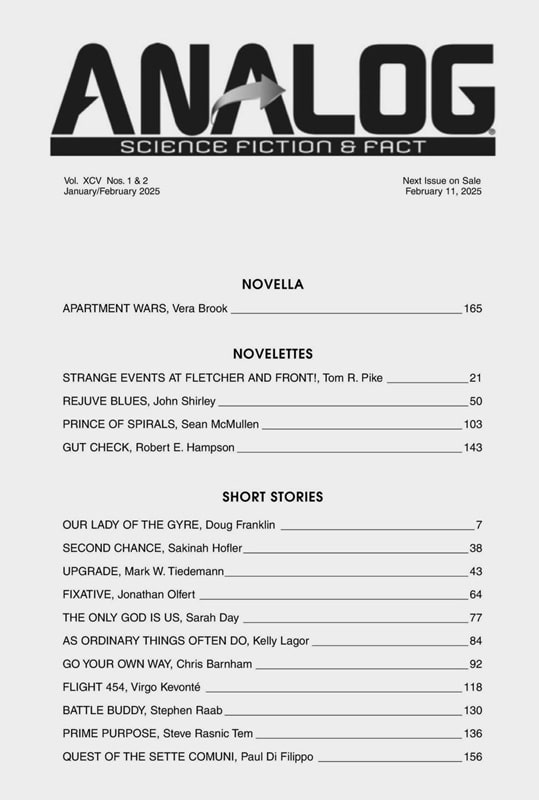
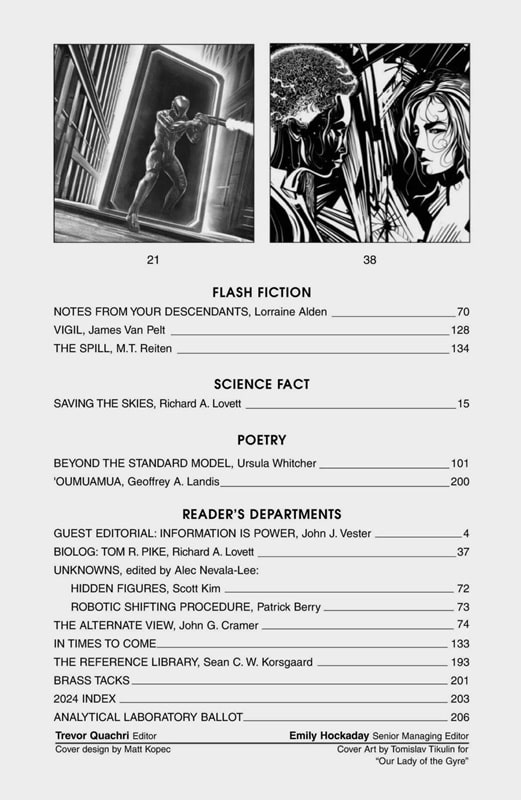
Contents of the January-February 2025 issue of Analog Science Fiction
Editor Trevor Quachri gives us a tantalizing summary of the current issue online, as usual. Sadly, I didn’t think to grab a copy before the latest issues dropped. Next time.
Here’s the full TOC.
Novella
“Apartment Wars” by Vera Brook
Novelettes
“Strange Events at Fletcher and Front!” by Tom R. Pike
“Rejuve Blues” by John Shirley
“Prince of Spirals” by Sean McMullen
“Gut Check” by Robert E. Hampson
Short Stories
“Our Lady of the Gyre” by Doug Franklin
“Second Chance” by Sakinah Hofler
“Upgrade” by Mark W. Teidemann
“Fixative” by Jonathan Olfert
“The Only God is Us” by Sarah Day
“As Ordinary Things Often Do” by Kelly Lagor
“Go Your Own Way” by Chris Barnham
“Flight 454” by Virgo Kevonté
“Battle Buddy” by Stephen Raab
“Prime Purpose” by Steve Rasnic Tem
“Quest of the Sette Comuni” by Paul Di Filippo
Flash Fiction
“Notes From Your Descendants” by Lorraine Alden
“Vigil” by James Van Pelt
“The Spill” by M.T. Reiten
Science Fact
Saving the Skies: How One Small City in Arizona is Pointing the Way to a Better (Darker) Way, by Richard A. Lovett
Poetry
Beyond the Standard Model by Ursula Whitcher
‘Oumuamua by Geoffrey A. Landis
Reader’s Departments
Guest Editorial: Information is Power by John J. Vester
Biolog: Tom R. Pike by Richard A. Lovett
Unknowns, edited by Alec Nevala-Lee:
Hidden Figures by Scott Kim
Robotic Shifting Procedure by Patrick Berry
The Alternate View by John G. Cramer
In Times to Come
The Reference Library by Sean C.W. Korsgaard
Brass Tacks
2024 Index
Upcoming Events by Anthony Lewis
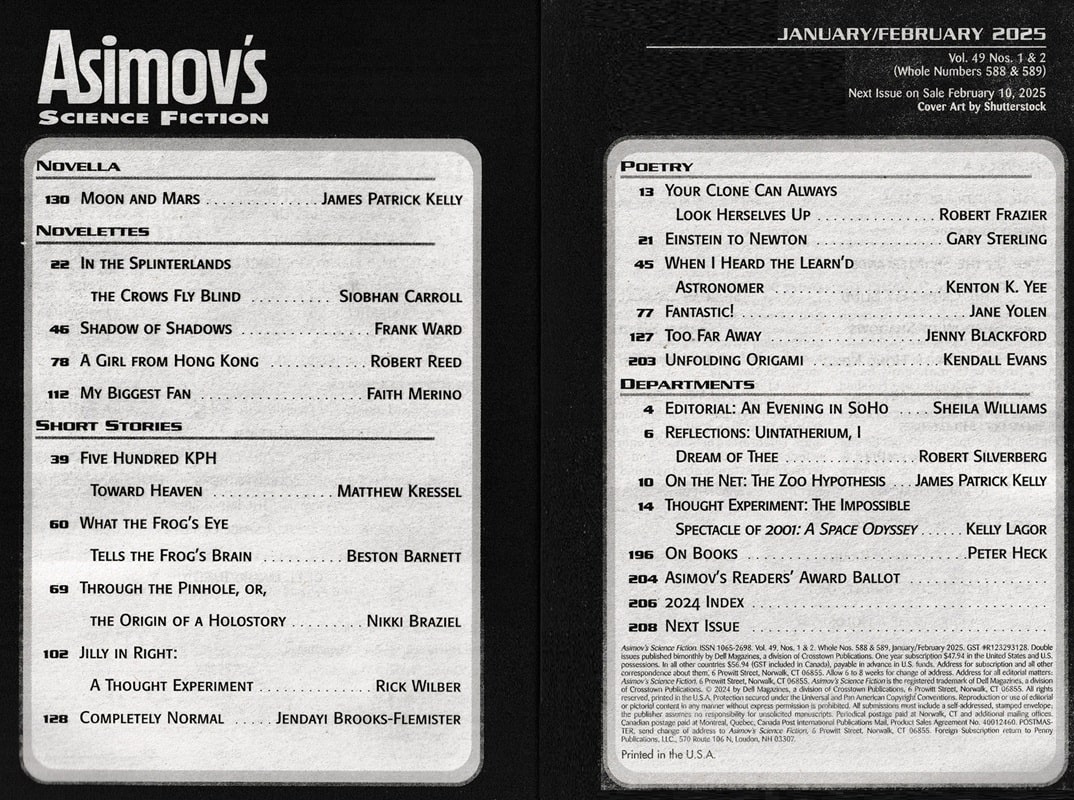 Contents of the January-February 2025 issue of Asimov’s Science Fiction
Asimov’s Science Fiction
Contents of the January-February 2025 issue of Asimov’s Science Fiction
Asimov’s Science Fiction
Sheila Williams provides a handy summary of the latest issue of Asimov’s at the website. But I missed it this month. Next time I’ll remember before it’s gone.
Here’s the complete Table of Contents.
Novella
“Moon and Mars” by James Patrick Kelly
Novelettes
“In the Splinterlands, the Crows Fly Blind” by Siobhan Carroll
“Shadow of Shadows” by Frank Ward
“A Girl from Hong Kong” by Robert Reed
“My Biggest Fan” by Faith Merino
Short Stories
“Five Hundred KPH Toward Heaven” by Matthew Kressel
“What the Frog’s Eye Tells the Frog’s Brain” by Beston Barnett
“Through the Pinhole, Or, the Origin of a Holostory” by Nikki Braziel
“Jilly in Right: A Thought Experiment” by Rick Wilber
“Completely Normal” by Jendayi Brooks-Flemister
Poetry
Your Clone Can Always Look Herselves Up by Robert Frazier
Einstein to Newton by Gary Sterling
When I Heard the Learn’d Astronomer by Kenton K. Yee
Fantastic! by Jane Yolen
Too Far Away by Jenny Blackford
Unfolding Origami by Kendall Evans
Departments
Editorial: An Evening in SoHo by Sheila Williams
Reflections: Uintatherium, I Dream of Thee by Robert Silverberg
On the Net: The Zoo Hypothesis by James Patrick Kelly
Thought Experiment: The Impossible Spectacle of 2001: A Space Odyssey by Kelly Lagor
On Books by Peter Heck
Asimov’s Readers’ Award Ballot
2024 Index
Next Issue
Analog, Asimov’s Science Fiction and The Magazine of Fantasy & Science Fiction are available wherever magazines are sold, and at various online outlets. Buy single issues and subscriptions at the links below.
Asimov’s Science Fiction (208 pages, $8.99 per issue, one year sub $47.97 in the US) — edited by Sheila Williams
Analog Science Fiction and Fact (208 pages, $8.99 per issue, one year sub $47.97 in the US) — edited by Trevor Quachri
The Magazine of Fantasy & Science Fiction (256 pages, $10.99 per issue, one year sub $65.94 in the US) — edited by Sheree Renée Thomas
The January-February issues of Asimov’s and Analog were on sale until February 11. See our coverage of the November-December issues here, and all our recent magazine coverage here.
What a Croc, Part III
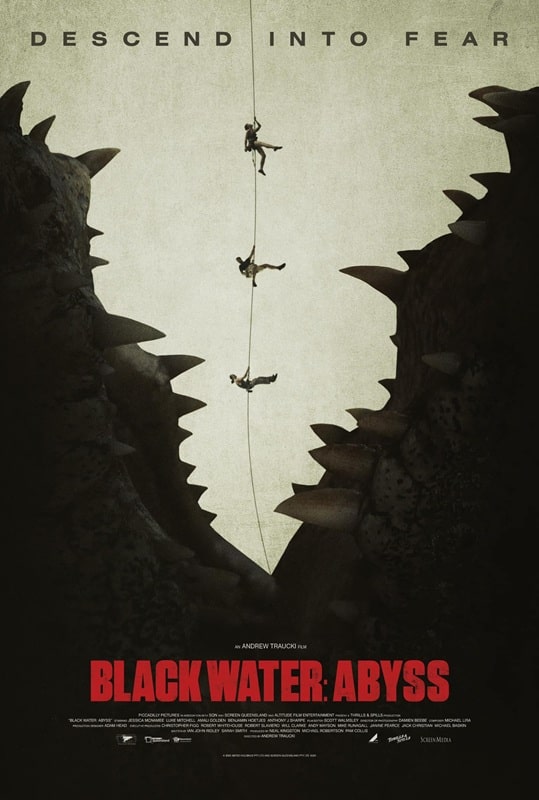 Black Water: Abyss (Altitude Film Entertainment, July 10, 2020)
Black Water: Abyss (Altitude Film Entertainment, July 10, 2020)
My next watch-a-thon is a favorite genre: crocs and gators. Unfortunately, this means the pickings are a bit slim, as I’ve already seen most of them, but I’ve managed to dig up 15 so far (supplemented with a Gila Monster and a couple of Komodos), and I’m sure the intended list of 20 will materialize as streaming services start suggesting titles.
What a Croc #14: Black Water: Abyss (2020) CrackleCroc or gator? Crocodile!
Real or faker? Some pretty great CG.
Any good? I do like me an Aussie croc flick, and this is one of them. The premise is simple: stick some folks in a cave, flood it, trap them, let loose a big croc. The spaces are tight, the tension is taut, and the croc has the good sense to eat the cast in order of character development.*
There’s a bit of relationship drama in the mix between meals, but at the end of the day it’s just a murky cocktail of Rogue and The Decent, but doesn’t come close to being as good as either. Still, I didn’t hate it, and it was well produced, so I’ll grade it a little higher.
7/10
*Now where have I seen that poster design before…?

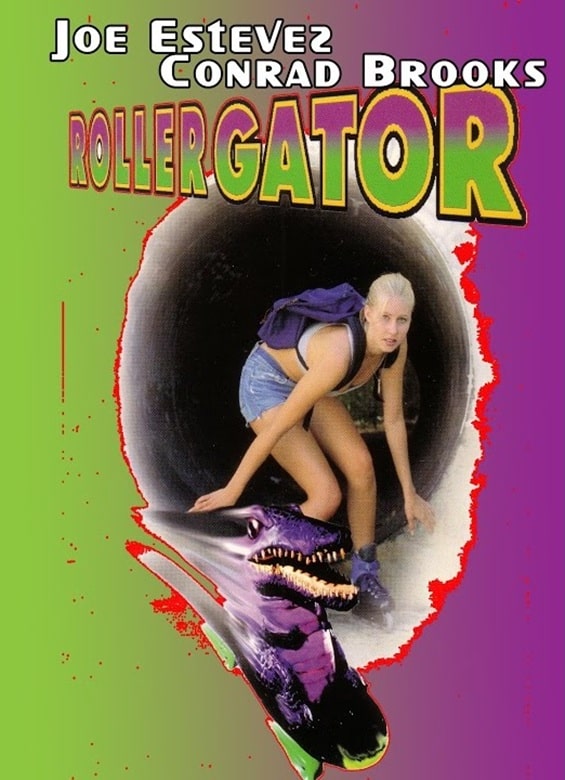
Lake Placid: The Final Chapter (Syfy, September 29, 2012) and Rollergator (RiffTrax, 1996)
Croc or gator? Alligator(s)!
Real or faker? All terrible CG.
Any good? I still have fond memories of the first time I watched Lake Placid — I was totally unprepared for the all round brilliance of it, from the writing and the cast to the effects and direction. Sadly, each successive sequel has been horrendous, and this one, the incorrectly named ‘Final Chapter’ is the penultimate nail in the coffin.*
As you can tell from the ‘quality’ poster, the story is trite, the characters uninteresting and the effects garbage — the only redeeming features might be Robert England (hamming it up in another gator flick), and Yancy Butler (wasted here as she reprises her role as a two-pack-a-day-voiced rogue ranger). The most egregious aspect of this one though, is the directing and editing. There’s only one director who can get away with that many crash zooms, and his name is Sam Raimi.
Raimi did not direct this.
4/10
*I just discovered there are actually TWO more Lake Placid films after this one. Not that it makes this any easier.
What a Croc #16: Rollergator (1996) TubiCroc or gator? Gator. Small. Purple.
Real or faker? A hand puppet.
Any good? I tried to find the original version of this, but had to settle for the Rifftrax version. Shocking admission: I don’t find Rifftrax particularly funny (not a huge fan of MST3K either) and they just paved the way for stuff like CinemaSins and every other armchair critic who thinks they’re funny. I am fully aware of the staggering hypocrisy of this statement, but there you go.
Anyway, in this film a roller skating woman meets a small, jive talking gator and tries to get him out of the carnival and back to the swamp. Presumably written by a third-grader, it’s utter crap. Not even funny or surreal enough to be a guilty pleasure — just a miserable, miserable slog.
1/10
 Mega Shark vs. Crocosaurus (The Asylum, December 21, 2010)
What a Croc #17: Mega Shark vs. Crocosaurus (2010) YouTube
Mega Shark vs. Crocosaurus (The Asylum, December 21, 2010)
What a Croc #17: Mega Shark vs. Crocosaurus (2010) YouTube
Croc or gator? Croc. Osaurus.
Real or faker? Rubbish CG.
Any good? You know what the answer is going to be, so let’s just cut to the chase. Robert Picardo is a fine actor, he voiced the male, culturally-obsessed alien in Joe Dante’s Explorers and I love him for that. He’s also good in everything else, but I guess he needed a new deck, because he’s in this.
Gary Stretch is also in this. British boxing fans may remember the name, the rest of you will just know him as a punching bag-faced enigma with the looks of a leading man and the mystery of a Swiffer. Sarah Lieving stars opposite him as a potentially badass special investigator who is relegated to scowling boobily at the rest of the cast while flying a pretend helicopter.
The story is rote, the direction and editing are dull and the effects are tragic. The titular creatures (especially the giant croc) are rendered in spectacular blur-o-vision, unhindered by weight or physics. I feel neither joy nor despair at having watched this film, I’m just languishing in a limbo populated by cookie cutters, tight vests and pixels.
4/10

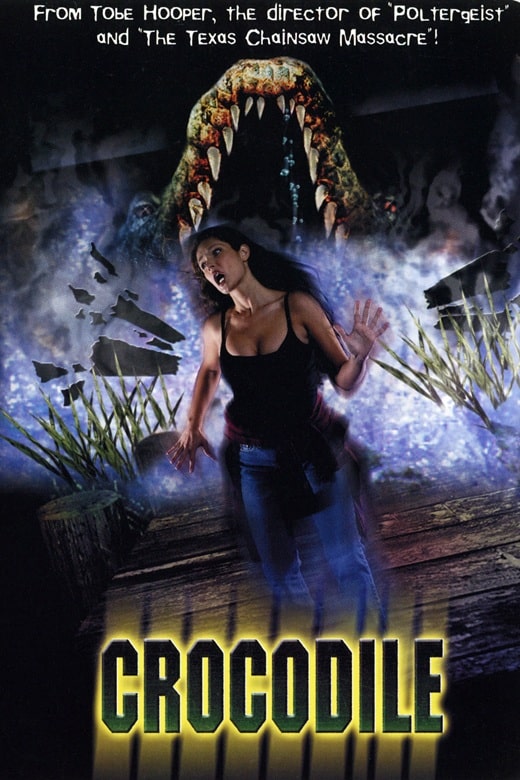
Croczilla (Beijing Enlight Pictures, 2012) and Crocodile (Lions Gate, August 26, 2000)
Croc or gator? Crocodile. Big boi.
Real or faker? Fairly decent CG (in parts).
Any good? I started watching this one quite early on in the watch-a-thon, and thought it had promise, so saved it to end on a high note. It is indeed fun, however, I would sorely love to see a subtitled version, as the English dubbing on this Chinese movie is horrendous.
Promoted as China’s ‘first monster movie’, a claim that has been made on several of the films I’ve watched from China, Croczilla is meant to be a tongue-in-cheek flick. For this reason, the actors ham it up to the level of cartoon characters, and the English V.O. artists were apparently told to do the same, because the dubbing is ear-splittingly intolerable, especially the voice of Barbie Hsu’s character, which threatened to shatter every window in the house.
Aside from the audio hell, it’s a jolly romp, with a 36 ft croc on the rampage in Hangzhou, its belly full of Yuan (about a million worth, or 100,000 Euros as the shrill dubbing informs us). The cast is likeable (although the gangsters are a trifle over the top), and the croc itself is a nice bit of CG. It’s a great model, and for the most part animated well, but some of the interactions with its environment weren’t great. Overall, I enjoyed it, and that’s what matters, so there.
7/10
What a Croc #19: Crocodile (2000) CrackleCroc or gator? Crocodile.
Real or faker? Some OK animatronics and rubbish CG.
Any good? Apparently, when I said Eaten Alive was the only Tobe Hooper film I hadn’t seen, I had forgotten about this one — and I wish it had remained forgotten. I was initially excited when I saw Hooper’s name, doubly so when I saw the effects were done by Nicotero and Berger, but it seems there was no budget for effects and Hooper couldn’t give two shits about the film.
Nobody brings anything fresh to the production, it’s the same tired old story of unlikeable frat kids getting drunk and horny in a swamp, and the only reason to watch is to see how they get dispatched. Unfortunately, save for a couple of fun shots of folks sliding down a gullet, it’s all a bit ham-fisted, and the CG croc suffers from the same weightlessness as all the other low-budget beasts of the era. A shame.
5/10
 Crocodile 2: Death Swamp (Nu Image Films, August 1, 2002)
What a Croc #20: Crocodile 2: Death Swamp (2002) Crackle
Crocodile 2: Death Swamp (Nu Image Films, August 1, 2002)
What a Croc #20: Crocodile 2: Death Swamp (2002) Crackle
Croc or gator? Crocodile. Again.
Real or faker? Some pretty great animatronics.
Any good? Hot on the heels of the disappointment of Crocodile comes Crocodile 2, which chose to ignore sequel conventions and be titled Crocodiles. Also surprisingly, it is that rare breed, the superior sequel, and I had a lot of fun with it.
No hackneyed ‘hot kids in a swamp’ plot, this one is full of bank robberies, plane crashes and helicopter hijinks. The bad guys are extremely potty-mouthed and awful enough to cheer when they get eaten, and the plucky protagonists put up a fair fight. The effects are actually pretty gruesome, and the croc itself is one of the better ones I’ve seen. Good heavens, I do believe I’ve ended on a high note!
8/10
That’s the crocs and gators done. Next up, werewolves!
Previous Murkey Movie surveys from Neil Baker include:
What a Croc, Part I
What a Croc, Part II
Prehistrionics
Jumping the Shark
Alien Overlords
Biggus Footus
I Like Big Bugs and I Cannot Lie
The Weird, Weird West
Warrior Women Watch-a-thon
Neil Baker’s last article for us was What a Croc, Part II. Neil spends his days watching dodgy movies, most of them terrible, in the hope that you might be inspired to watch them too. He is often asked why he doesn’t watch ‘proper’ films, and he honestly doesn’t have a good answer. He is an author, illustrator, outdoor educator and owner of April Moon Books (AprilMoonBooks.com).
Love of Family & Land in “A Fort of Nine Towers” by Qais Akbar Omar
A Fort of Nine Towers is one of the rare memoirs of Afghanistan to have…
The post Love of Family & Land in “A Fort of Nine Towers” by Qais Akbar Omar appeared first on LitStack.
THE FROZEN PEOPLE by Elly Griffiths
Book Review: Emily Wilde’s Compendium of Lost Tales by Heather Fawcett
I received a review copy from the publisher. This does not affect the contents of my review and all opinions are my own.
 Emily Wilde’s Compendium of Lost Tales by Heather Fawcett
Emily Wilde’s Compendium of Lost Tales by Heather Fawcett
Mogsy’s Rating: 4 of 5 stars
Genre: Fantasy
Series: Book 3 of Emily Wilde
Publisher: Del Rey (February 11, 2025)
Length: 368 pages
Author Information: Website
Having followed Emily and Wendell’s journey through the first two books of this series, I was excited to see how the trilogy will end, especially now with the weight of a faerie realm hanging in the balance. I’m happy to say Emily Wilde’s Compendium of Lost Tales delivers a satisfying and enchanting conclusion that offers the perfect balance between adventure, scholarly curiosity, and whimsical charms—all the things that made me fall in love with this series in the first place.
Before we proceed, a mild spoiler warning for the previous books if you haven’t caught up yet. The story finds Emily Wilde and her fiancé, Wendell Bambleby, coming to terms with their new roles as rulers of Wendell’s ancestral kingdom in Faerie. As someone who has dedicated her life to dryadology, or the study of faeries, Emily has always preferred learning about her beloved subject from the safety of university classrooms and libraries. This new development, however, will thrust her out of her comfort zone and into the dangerous politics and intrigues of the fae world. And things are not exactly stable right now in Wendell’s realm!
Before vanishing, Wendell’s spiteful and ruthless stepmother Queen Arna had placed a curse on the land, leaving it clinging onto life. To lift the curse and return the realm to normal, Emily leaps into her role as the new queen not only to support Wendell, but also to stay true to her academic roots, resolving to find an answer in her rich knowledge of faerie stories. In this world, she may feel like a fish out of water, but when it comes to fae lore, there is no greater expert. If there’s even a grain of truth in these legends, or a clue that may help, our protagonist is determined to find it.
For a sequel that picks up right after the previous book left off, Emily Wilde’s Compendium of Lost Tales gets off to a relatively slow start. For the first half of the book, it feels as if barely anything happens. Sure, Wendell has to face up to his new responsibilities as king, going through the motions of posturing and winning a few duels here and there. But for the most part, we don’t move past much past the central conflict that his realm is under threat. Emily also plays her role as an outsider, perhaps a bit too well. This section sees her without much agency, being tossed around the court, doing wherever her new duties as acting queen requires of her. She’s meek, she’s unsure, and she spends a lot of this time either going with the flow or simply staying out of the way.
That said, there is a silver lining. We’ve spent most of the last two books in Emily’s sphere of influence, but we’re in Wendell’s now. And what we learn is that sweet, easygoing Wendell can in fact be very scary if the need calls for it. The interactions become so much more interesting in this new dynamic, for while the relationship and banter between our two main characters remain light and airy, we can tell Emily is still getting used to seeing Wendell in his new role. Of course, she is still important to him, and the romance between them is alive and well. But with his kingdom and his people in peril, there are other things to occupy his attention. It’s a significant adjustment— not just for our protagonist, but for me as a reader as well.
Perhaps not coincidentally, the story picks up at around the same time Emily regains some of her confidence reflected in the passion for her work. That’s when both the novel’s pacing and the world’s imagination come alive again. Emily’s no-nonsense intellect takes over, making some headway into finding a solution, all the while giving readers a chance to indulge in delightful fae lore. As she delves deeper, the book’s vibe shifts to weaving in intrigue and danger, with the tensions building to a satisfying conclusion.
In the end, Heather Fawcett gives us fans the gift of a strong final installment in Emily Wilde’s Compendium of Lost Tales. This ending might have been heartfelt and bittersweet in its poignancy yet still felt just right—a fitting farewell to our unforgettable couple, Emily and Wendell.
![]()
![]()
More on The BiblioSanctum:
Review of Emily Wilde’s Encyclopaedia of Faeries (Book 1)
Review of Emily Wilde’s Map of the Otherlands (Book 2)
The Fiction of Edgar Rice Burroughs, Part III: The Westerns and The Mucker
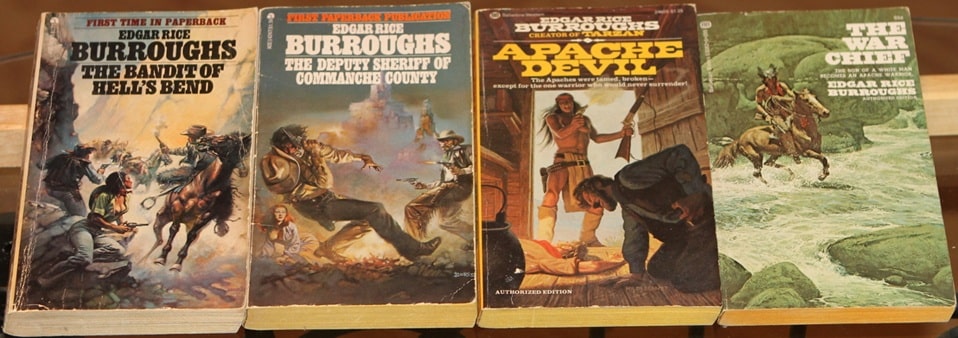 Westerns by Edgar Rice Burroughs: The Bandit of Hell’s Bend and The Deputy Sheriff of Commanche County (Ace Books); Apache Devil and The War Chief (Ballantine Books). Covers by Boris Vallejo, the Brothers Hildebrandt, and Frank McCarthy.
Westerns by Edgar Rice Burroughs: The Bandit of Hell’s Bend and The Deputy Sheriff of Commanche County (Ace Books); Apache Devil and The War Chief (Ballantine Books). Covers by Boris Vallejo, the Brothers Hildebrandt, and Frank McCarthy.
Like many pulp writers of his day, ERB dipped his toes into the western genre. He wrote four: two pretty standard ones and two that incorporate the Native American experience. He knew something of what he wrote, having worked on his brother’s ranch in Idaho at age 16, and having served with the 7th cavalry in Arizona in the late 1890s.
His first standard western was The Bandit of Hell’s Bend (1924), followed by The Deputy Sheriff of Commanche County in 1940. Both of my copies are later printings from Ace with very cool Boris illustrations. I like these better than many of Boris’s paintings because they seem less static. He does a good job of portraying action here.
In Bandit, we have a disgraced ranch foreman and a young woman who has inherited the ranch, and various villains who want to steal the ranch from her because they know there’s silver on it. The foreman, Bull, has to rise to the occasion. There’s great action and pretty good plotting, although you’ll probably figure it out pretty soon. And, as always, ERB creates sympathetic heroes and dastardly villains.
In Deputy Sheriff, a cowboy named Buck Mason is suspected of a murder he didn’t commit, and he has to run and hide until he has a chance to prove his innocence. This plot is not as good as Bandit but it gets the job done to showcase ERB’s lightning paced tale.
ERB’s other two westerns are connected and center very strongly on the Native American experience. The hero, though, is a white boy who is taken captive by Apaches and raised as Geronimo’s adopted son. He is given the Apache name of Shoz-Dijiji (Black Bear), for having killed one at a young age, and he grows up hating whites.
These books are The War Chief (1927), and Apache Devil (1933). Although there are some stereotypical elements to these books, they show that ERB had very strong sympathies for the Apache and disapproved of the way they had been treated by whites.
I found all of these books well worth reading, though the Apache books have stayed with me the longest. The cover art for The War Chief is magnificent and is by Frank McCarthy. The Apache Devil cover looks to be signed by Hildebrandt.
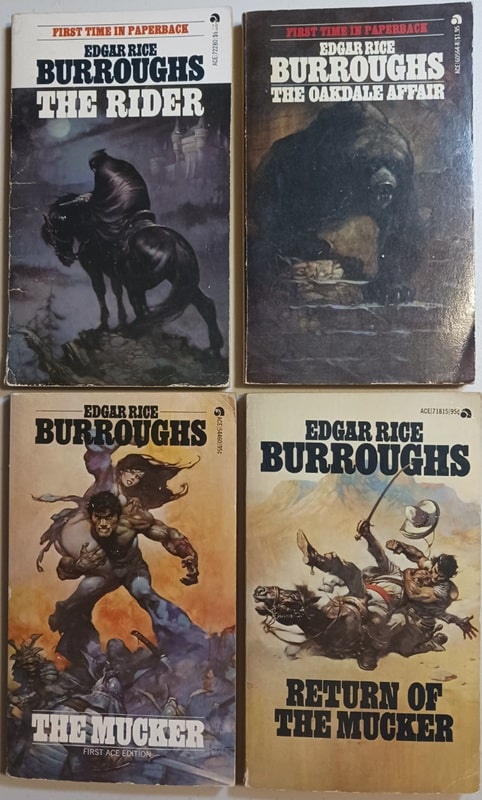 The Rider, The Oakdale Affair, The Mucker, and Return of the Mucker (Ace Books). Covers by Frank Frazetta.
The Rider, The Oakdale Affair, The Mucker, and Return of the Mucker (Ace Books). Covers by Frank Frazetta.
ERB wrote a three book series generally called The Mucker. They were first published in magazines in the mid to late 1910s, but I have much later reprints, of course, from the 1970s. All of mine, shown here, are from Ace books with Frazetta covers. I particularly like the first book cover, although all are cool.
The Mucker (1914). Billy Byrne is born on the mean streets of Chicago and grows up a criminal. After being accused of murder, he flees to San Francisco and ends up shanghaied. A shipwreck leaves him and a beautiful high society girl stranded in an east Asian jungle and she needs rescuing. I really liked the development of the character here. Through love, Billy learns how to be a decent human being and becomes quite a hero.
The Return of the Mucker (1916). This book finds Billy trying to clear himself of his previous murder charges and failing. He ends up in Mexico in the midst of a revolution. And it so happens that his love interest from the first book, Barbara, is also there. The Mucker was a very fine novel but the sequel is pretty weak. Coincidences pile upon coincidences until it’s pretty hard to suspend belief. But it still has the action rolling. This one could easily be counted as one of his westerns given the setting.
The Oakdale Affair (1918). I’m not sure what ERB was striving for with this book. It’s got mystery elements, gothic elements, horror elements, western type elements. He put everything and the kitchen sink into this one. But it worked and I enjoyed it. It is only peripherally related to the Mucker stories in that it features a hobo character that appeared in The Return of the Mucker.
I included ERB’s The Rider here because of the Frazetta cover and because it was at one point published in a double with The Oakdale Affair. But it’s not part of the Mucker series. It involves a bandit called “The Rider” who exchanges places with a prince (Boris) who is about to be married to the princess of another European duchy (neither of whom want to marry the other). Chaos ensues. ERB crammed a lot of action and plot twists into this short work.
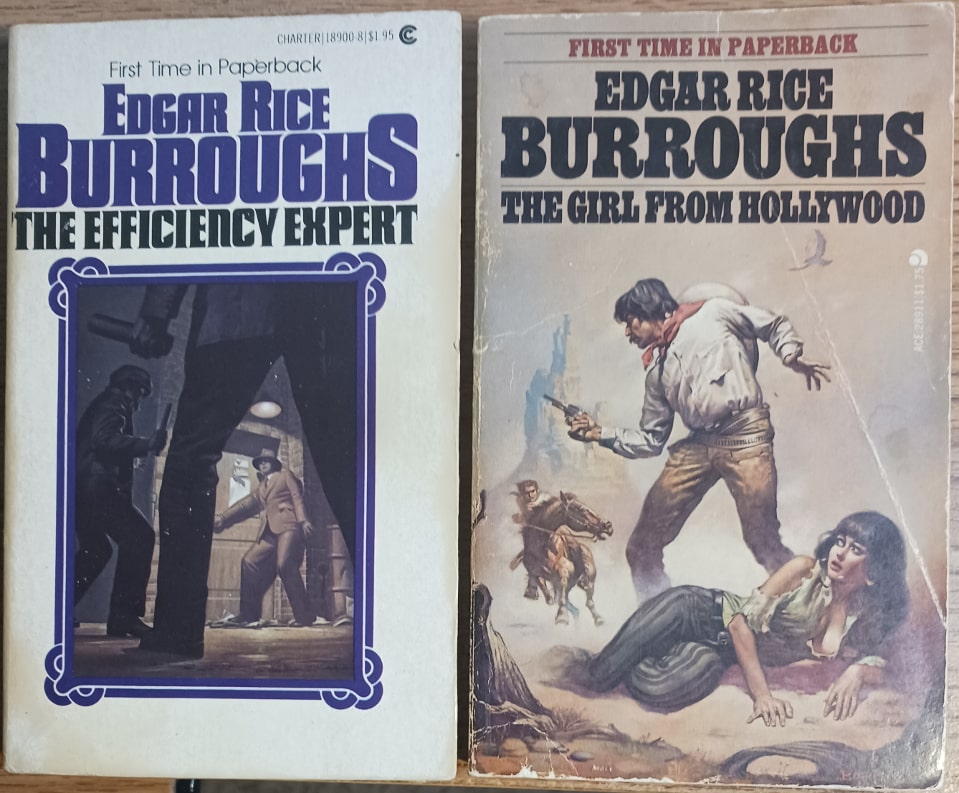 The Efficiency Expert (Charter, 1979) and The Girl From Hollywood (Ace Books, 1977). Covers by John Rush and Boris Vallejo
The Efficiency Expert (Charter, 1979) and The Girl From Hollywood (Ace Books, 1977). Covers by John Rush and Boris Vallejo
My favorite genres are Fantasy, SF, Westerns, Horror, and Thrillers. I don’t read a lot of straight mysteries and read relatively little “mundane” fiction. By mundane, I mean fiction set in a modern world where the happenings are portrayed as realistic. After reading ERB’s westerns and everything he wrote with fantastic elements, I was left with three books: The Girl from Hollywood, The Efficiency Expert, and The Girl From Farris’s.
They were also among the more difficult ERB books to find and were expensive, but I wanted them because they were… well, ERB. I got both Girl and Efficiency in 1970’s paperback form but couldn’t get Farris and finally ordered it in a modern paperback printed from public domain materials. Here are my capsule reviews.
The Girl from Hollywood (ACE, 1977, Boris Cover) is not quite a western. It takes place in the 1920s, but much is set in a western landscape and involves many western tropes. The plot involves a fine western family whose lives become entangled with Hollywood types. Some of these are basically good and recover from their evil natures while others never do.
As is typical of ERB’s work, there are coincidences that help the plot along, and there’s actually very little action compared to his typical story. However, the sheer narrative drive that ERB was able to bring to his tales keeps you reading. I finished it in one day, if not quite one sitting. Not my favorite work by him by far, but still enjoyable.
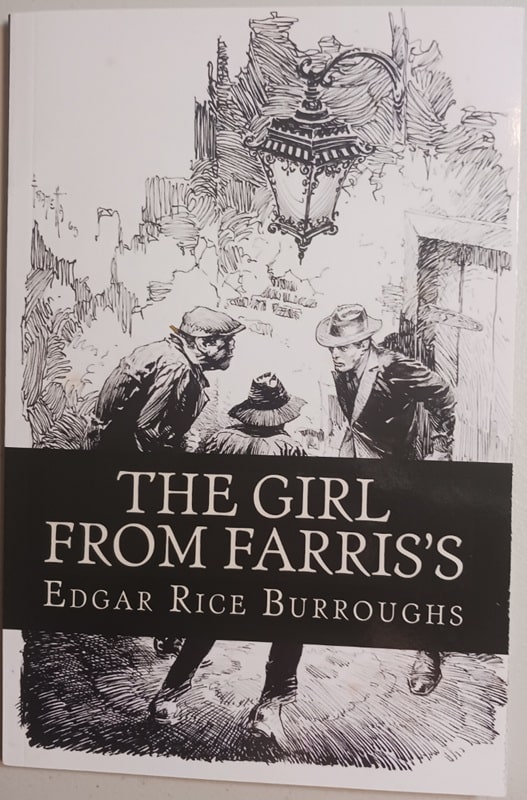 The Girl from Farris’s (CreateSpace edition, 2017). Cover by Frank Frazetta
The Girl from Farris’s (CreateSpace edition, 2017). Cover by Frank Frazetta
The Girl from Farris’s (Public Domain, from CreateSpace, 2017). The cover is by Frank Frazetta. An editorial note names Taylor Anderson as editor, and claims the publisher is Odin’s Library Classics. The text appears to be intact but the print is small and there are no indented paragraphs. I actually read this in ebook version, though, so I’ll just stick it on my shelves. I rather like the cover but don’t know where it came from.
“Farris’s” is a house of ill repute and June Lathrop a lady of the evening who is trying to escape it. She meets a young man — Ogden Secor — who wants to help her and fate keeps throwing them together. It’s a tale of redemption, which is an element in all three of these novels. One particularly interesting point is that Ogden is a failed Chicago businessman who tries to make a new life for himself in Idaho. ERB himself fled the business world of Chicago for his brother’s Idaho ranch. They say, “write what you know.”
The Efficiency Expert (Charter, 1979, cover by John Rush) is the last Burroughs book I’ve read, and very nearly the last one to exist that I hadn’t read. I left these three to last thinking they weren’t much up my alley. None of them have any fantastic elements. Efficiency Expert is a straightforward and realistically based story of a young man of quality who is down on his luck but never succumbs to corruption and wins out in the end. I was engrossed throughout. There’s certainly plenty of coincidence featured in the plot but I didn’t mind it much and even without a lot of action happening, it had narrative drive and kept my attention.
I’d rate Efficiency the best of the three, followed by Hollywood and Farris’s.
We’ll wrap up Burroughs next time with a look at his Hollow Earth tales.
Previous installments in this series include:
The Fiction of Edgar Rice Burroughs, Part I: Sword and Planet
The Fiction of Edgar Rice Burroughs, Part II: Tarzan and The Land That Time Forgot
Charles Gramlich administers The Swords & Planet League group on Facebook, where this post first appeared. His last article for Black Gate was The Fiction of Edgar Rice Burroughs, Part II: Tarzan and The Land That Time Forgot.
Taken by an Immortal Elf - Book Review by Voodoo Bride
 Taken by an Immortal Elf(Elves Among Us: Forbidden Love #0.5)by L.E. Sunwick
Taken by an Immortal Elf(Elves Among Us: Forbidden Love #0.5)by L.E. SunwickWhat is it about:My captor sees me as one of those destroying his sacred forest. I see him as the most gorgeous male on earth.So handsome. Those muscles. That athletic self-confidence. He is an immortal elf more than a century older than I. He calls me a lioness because I stand up to my wealthy uncaring parents - and him. Ours is a forbidden attraction. He is an elf of legend. I am a mortal duchess and a human he does not trust. We cannot be together.But I would sacrifice my happiness to save his sacred lands from my parents’ greed. My brief time with him was a lifetime’s worth. If I don’t do something, lives - and our budding love - may be lost. Even the courage and prowess of a hundred real lionesses may not be enough. But for a tiny chance at true love, I am willing to find out.
What did Voodoo Bride think of it:I recently participated in one of those 'Stuff your Kindle' events, and got signed up for tons of newsletters because of it. One of them was the newsletter of L.E. Sunwick. When there was a call for ARC/early readers for a rewritten book 1 in this series I got curious, signed up, and dug through my Kindle app what story of L.E. Sunwick I downloaded. It turned out to be this prequel story, so I decided to immediately give it a try.
And this turned out to be such an enjoyable read, that has several things I can't resist in my romances.
Hunky immortal elf: check!Heroine I liked from the start: check!Forbidden Love: double check!
This is a short story (82 pages), but it feels complete, and has romance, action, steam, and sacrifice. I finished this in no time at all, and you can be sure I'm already looking forward to reading more in this series. Each book can be read as a standalone as well I've been told, so I might check out book 2 soon.
Why should you read it:It's a very enjoyable Fantasy Romance read
Goth Chick News: (Another) Throwback Thursday – Johnny Depp, Roman Polanski, and The Club Dumas
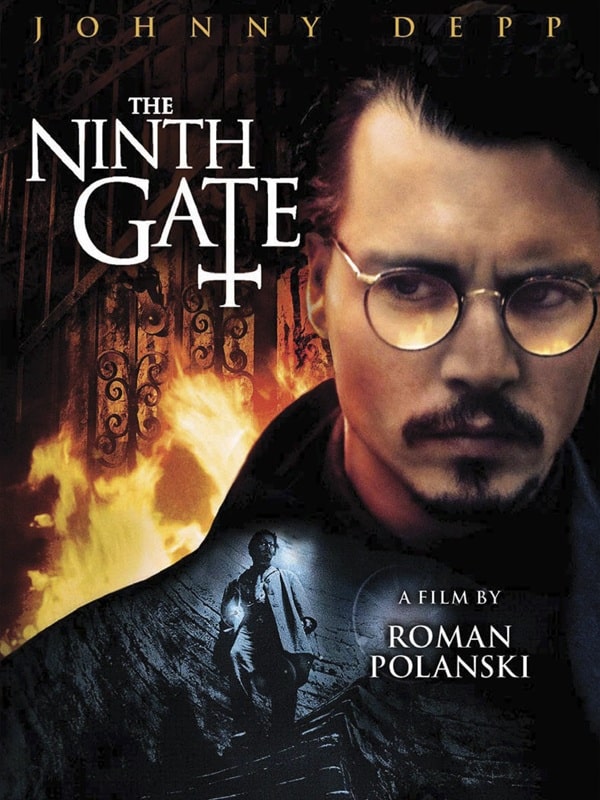 The Ninth Gate (Summit Entertainment, 1999)
The Ninth Gate (Summit Entertainment, 1999)
Last week’s article on Angel Heart not only resulted in a lot of fun and insightful comments from all of you, but it got me thinking about another film that I appreciate in a similar way. It will be twenty-six years old next month and having given it a re-watch last weekend, I wondered what your thoughts would be on this one.
The Ninth Gate, directed by Roman Polanski and starring Johnny Depp, was released in March 1999. Polanski was co-writer on the screenplay which was loosely (and I do mean loosely) adapted from the book, The Club Dumas (1993) by Arturo Pérez-Reverte.
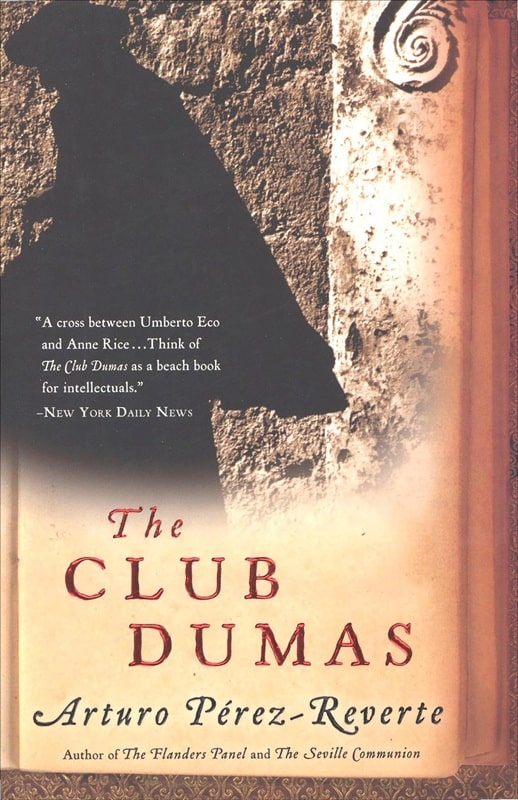 The Club Dumas by Arturo Pérez-Reverte (HarperVia, May 1, 2006)
The Club Dumas by Arturo Pérez-Reverte (HarperVia, May 1, 2006)
In the film, Dean Corso (Depp) is a New York book dealer with a reputation for unscrupulous methods. When Boris Balkan (Frank Langella), a wealthy collector of rare books on the occult, hires him to authenticate a mysterious tome called The Nine Gates of the Kingdom of Shadows, Corso embarks on a journey across Europe.
The book, rumored to summon the devil when used correctly, exists in three copies, but only one is authentic. Corso’s task is to examine the three editions and uncover the truth. As Corso delves deeper into his investigation, strange deaths and supernatural occurrences begin to haunt his steps. Along the way, he is joined by a mysterious woman (Emmanuelle Seigner), whose true nature seems tied to the book’s sinister secrets.
In parallel with Angel Heart, The Ninth Gate presents a dark journey into the unknown by a skeptical protagonist who is in over his head but doesn’t know it. The memorable visuals created by Darius Khondji, who is known for his work on Se7en, are well synchronized with the puzzle elements of the story and Polanski’s signature direction is evident as well. From dusty bookstores to candlelit castles, the cinematography oozes occult suspense all over the place.
I frankly love The Ninth Gate all the way up until its final few moments.
[Minor spoilers ahead.]
The film does a fabulous slow burn to what can only be described as an enigmatic conclusion, and this is why Angel Heart is still my favorite of the two films. While we aren’t at all confused as to what will become of Harry Angel, The Ninth Gate leaves viewers in the maddening position of wondering whether Dean Corso has unlocked forbidden knowledge, become ensnared in a deadly conspiracy, or gone to literal Hell – maybe all three. I remember screaming “NO!” at the screen when the credits rolled since all the fabulous creepiness that built through the entire film, simply went off a cliff at the very end, without resolution.
 Johnny Depp in The Ninth Gate
Johnny Depp in The Ninth Gate
That sent me straight to the source material to see if Polanski was being a jerk by leaving us with such an unsatisfactory conclusion. I immediately went out and bought a copy of The Club Dumas assuming that it would fill in some, if not all, of the missing pieces.
Nope.
While The Ninth Gate is based on The Club Dumas, it omits substantial portions of the novel, particularly a subplot about a lost chapter of The Three Musketeers. The film focuses solely on the occult storyline, which, by the way, is a sub, SUB plot of the book. If anything, the ending of the book was even more obtuse, with themes centered on literary puzzles and human obsession rather than a definitive supernatural climax.
Interestingly, the titular tome at the center of the film, called De Umbrarum Regni Novem Portis, or The Nine Gates of the Kingdom of Shadows, is a fictional text. Its design plays a significant role in the plot, with eerie and violent illustrations which are gruesomely brought to life in the form of the demise of several characters. The engravings within The Nine Gates book, which were painstakingly designed for the film, serve as the visual centerpiece of the story. Each engraving contains subtle differences across the editions, forming cryptic clues for Corso and the audience to unravel. For movie prop collectors, it is a highly recognizable and sought-after addition.
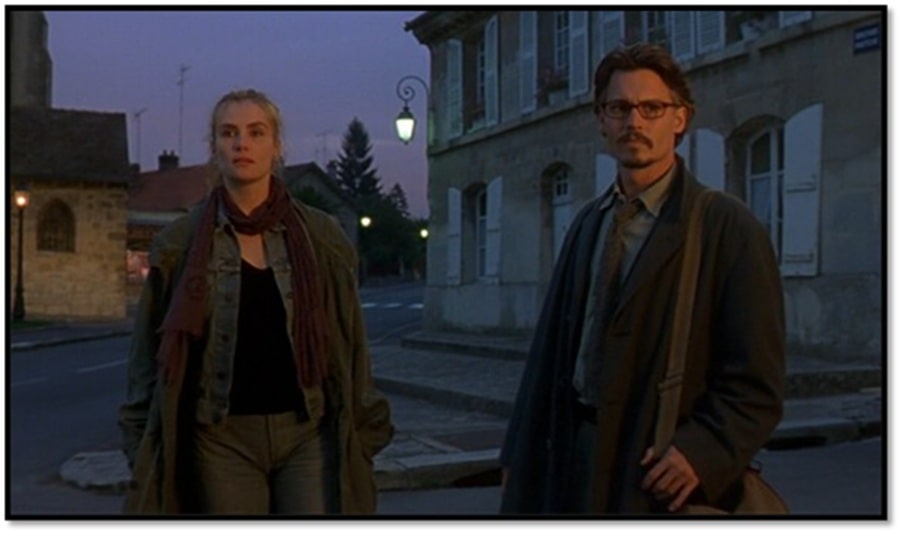 Emmanuelle Seigner and Johnny Depp in The Ninth Gate
Emmanuelle Seigner and Johnny Depp in The Ninth Gate
I used to have visions of owning my own copy of The Nine Gates, however, a well-made replica with a leather cover can go for upwards of $1200 or more. If you’re interested in a more attainable version, an engineer named Michael F. Haspil has created a detailed tutorial including the printable text and illustrations you’ll need to build one yourself, which you can find here.
Ultimately, The Ninth Gate received mixed reviews at the box office and made a rather crappy $58M against a $38M budget – so basically a bomb by Hollywood standards. Though critics praised its style, it was criticized for its pacing and lack of resolution. Despite that, The Ninth Gate has aged well with viewers like me who enjoy slow-burning mysteries and subtle horror. Depp delivers a restrained performance, grounding the fantastical story in a world of skepticism and pragmatism, while Frank Langella’s portrayal of Boris Balkan adds recognizable vice as a man consumed by his quest for power, at the peril of his soul.
The Ninth Gate’s blend of literary intrigue and supernatural tension makes it a film that (mostly) stands up over time. Whether you’re a fan of Polanski’s work, a lover of occult mysteries, or simply curious about the interplay between literature and cinema, The Ninth Gate is worth revisiting.
Thoughts?
Spotlight on “The Antidote” by Karen Russell
The Antidote is a gripping dust bowl epic about five characters whose fates become entangled…
The post Spotlight on “The Antidote” by Karen Russell appeared first on LitStack.
On McPig's Radar - A Web of Obsidian
 A Web of Obsidian(The Obsidian Sisterhood #1)by Lydia M. Hawke
A Web of Obsidian(The Obsidian Sisterhood #1)by Lydia M. HawkeAt 69 years old and with two martial arts black belts to her name, Sister Monica Barrett has never been one to back down from a fight. But the one that just landed on the ragged front lawn of the women’s shelter she runs may be more than she’s equipped to handle.
At first glance, the assailant in pursuit of a young woman seems like an all-too-familiar story. But this attacker has powers—he moves with uncanny speed, strikes with brutal accuracy, and isn’t after the woman at all. Instead, he wants what she has: a flat, black stone with a spider’s web embedded in it.
The instant Monica touches the stone, her world is turned upside down. Power surges through her and destroys her adversary—the kind of supernatural power that should belong only to the God she serves. A horrified Monica is determined to rid herself of the stone and whatever it holds, but with more attackers coming after her and the women she shelters, she needs to move fast.
Can Monica find where the stone came from before it falls into the wrong hands? Will it be safe to return it to its rightful place? Or has a nun of a certain age just inadvertently become the keeper of a dark power no human should wield?
Expected publication February 25, 2025
Track Her Down by Melinda Leigh
Mystery
When Claire returns home from work she discovers her parents, lying in bed, murdered. While investigating the murder Bree Taggert uncovers family secrets and a shocking motive.
Every now and then an author stumbles upon the magic sauce that makes a series great. Robyn Carr found it with Virgin River, Patricia Briggs with Mercy Thompson and Kendra Elliot nailed it with Mercy Kilpatrick. Bree Taggert is kind of like that. Melinda Leigh’s other series’ were good, even great, but Bree Taggert got everything right.
And when you hit that sweet spot there is a lot of pressure to keep going. Robyn Carr kept going with Virgin River way past its best before date. I wonder if Patricia Briggs is also approaching that point with Mercy Thompson. And in some ways this book feels like that. It’s good. Every bit as good as some of her other books, but it also feels like maybe the series has run its course and maybe it’s time to explore new ideas.
Overall, this book was good but not great. But there were opportunities in this book which were not explored and I hope Melinda Leigh planted those seeds to be explored in her next project.

Review: The Devils by Joe Abercrombie

Buy The Devils
OFFICIAL AUTHOR BIO: Joe Abercrombie was born in Lancaster, England, studied psychology at Manchester University, and worked as an editor of documentaries and live music before his first book, The Blade Itself, was published in 2006. Two further installments of the First Law trilogy, Before They Are Hanged and Last Argument of Kings, followed, along with three standalone books set in the same world: Best Served Cold, The Heroes, and Red Country. He has also written the Shattered Sea trilogy for young adults, the Age of Madness trilogy for old adults, and Sharp Ends, a collection of short stories. He lives in Bath, England, with his wife and three children. The Devils is his thirteenth novel.FORMAT/INFO: The Devils will be released by Tor Books on May 6th, 2025. It is 560 pages. It will be released in hardcover, ebook, and audiobook formats.
OVERVIEW/ANALYSIS: When Brother Diaz is summoned to the Sacred City, he's sure he is finally landing a prestigious position that will reflect his hard work and dedication. But instead of a noble, glorious assignment, he finds himself in charge of the Chapel of Holy Expediency, an arm of the wing the Church doesn't even officially acknowledge. Brother Diaz is now responsible for dangerous individuals, ranging from a blood-thirsty werewolf to an arrogant necromancer. Their current assignment: escort a lost princess across the continent and install her as the rightful empress of a neighboring empire. In their way: four dangerous cousins who want the princess eliminated so they can take the throne instead.
The Devils is another fantastic fantasy novel featuring that signature blend of Abercrombie: violence, crassness, and a host of memorable characters. Unsurprisingly, my favorite part of the story was the characters themselves. There are several POVs in this book, and every chapter felt like it had a distinctive voice. You could tell when it was a princess chapter versus a werewolf chapter versus a necromancer chapter. All these POV chapters provide insights into the characters themselves, which allows the readers to grapple with a real question: How dangerous are the members of the Chapel of Holy Expediency? Are they being unnecessarily prosecuted? Or has the Church accurately determined that these people are a clear and present danger to society if left unchecked? There is not a cookie cutter answer that applies to all of these characters, and it was intriguing to unpick their backstories and make my own judgement about them.
Speaking of the Church, let’s discuss the setting itself. The Devls is set in an alternate medieval Europe; while you’ll find references to familiar locations like England and Barcelona, you’ll also find the populace lives in fear of another invasion of cannibalistic elves. The Church is Christianity-adjacent, in that it worships one God, but they use different iconography, and their Savior is a woman, resulting in much of the upper Church leadership being women. All of this is in service of a VERY thinly veiled satirical critique of organized religion. It is a constant theme throughout the book, to the point of being slightly overdone.
The story itself was a blast to read. Our characters must journey from essentially the Vatican to Troy to return the lost princess to her throne. In their way are four royal cousins who want the throne for themselves, resulting in multiple attacks, traps, and attempts on the princess’s life. While individually, each fight is well done and distinctive, it did start to feel slightly repetitive by the end of this 500+ page book.
CONCLUSION: That doesn’t stop The Devils from having one heck of a gut punch as the story concludes. While the mission of this particular book, returning the princess to her throne, is wrapped up by the end, there are multiple tantalizing hooks dangling that foreshadow things to come. I myself cannot wait to see these characters come back and grapple with a new problem, and see how events from book one have (or haven’t changed) their outlooks. In short, The Devils is a fantastic opening for a trilogy that is sure to be thrilling and engaging journey.
Cover Reveal: Special Delivery by Rex Burke

OFFICIAL BOOK BLURB: A dangerous mission. A second chance.
Actually, scratch that. No chance.Dix’s career as a trooper in the Federation army is unblemished – until the day he disobeys a direct order and strikes an officer.
Now Dix has a choice. Face a life of hard labour that promises to be brutal and short. Or accept a mysterious invitation to join a black-ops mission in hostile terrain.
The plan sounds simple, if horribly dangerous. Fetch a fearsome weapon from a secret location and deliver it to a distant planet, whose population is under the chilling yoke of the Federation’s rival empire, the Axis. Do it without getting caught, or implicating the Federation, and Dix’s transgressions will be forgiven.
But the weapon turns out to be unlike anything he could have expected, and Dix’s troubles have only just begun.
'SAS Rogue Heroes' x 'Starship Troopers' – Special Delivery introduces a ragtag crew of misfits and malcontents on a mission with more holes than a blaster-riddled corpse. It’s a fluid, easy-reading, military-action Sci-Fi adventure, perfect for fans of Tanya Huff and John Scalzi.
Intriguing? Let's look at the cover, designed by: Chris Hudson

PREORDER your copy of Special Delivery here
OFFICIAL AUTHOR INFORMATION: Rex Burke is a SciFi writer based in North Yorkshire, UK.
When he was young, he read every one of those yellow-jacketed Victor Gollancz hardbacks in his local library. He’s sure there are still thrilling SciFi adventures to be told – even if he has to write them himself.
When he’s not writing, he travels – one way or another, he’ll get to the stars, even if it’s just as stardust when his own story is done.
Website: https://rexburke.com/
Contact: rex@rexburke.com
BlueSky: @rexburke.bsky.social
Let's hear from the author about how he came up with the idea from the book:
"Ideas for books come to me in all sorts of ways – the first germ of what became Orphan Planet was a disastrous camping trip one of my sons went on; The Wrong Stop came out of a lifetime spent travelling around Europe on trains, and wondering about the people I met on board.And sometimes a single thought is enough, and on one such train, early last year, two fully formed sentences popped into my head, unbidden. Here they are:
†'Their unit, OneSquad, had been fighting hard all day across difficult terrain. The planet was a squelching, crater-filled shithole, and Dix was covered in mud – at least, he hoped it was mud – but orders were orders.'
Those two sentences begin the book that is Special Delivery, which will be published in April.
I never set out to write a hard-edged Sci-Fi story about space troopers on a secret mission, but that's what my next book is – though you should be reassured that it's also full of banter, laughs, scrapes and mysteries. A traditional Rex Burke book, in fact, but this time set entirely in space, and with added fights, guns, blood, intrigue and betrayal."
7 Author Shoutouts | Authors We Love To Recommend
Here are 7 Author Shoutouts for this week. Find your favorite author or discover an…
The post 7 Author Shoutouts | Authors We Love To Recommend appeared first on LitStack.

Recent comments